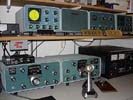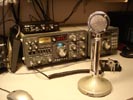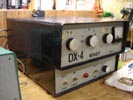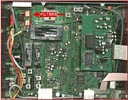

|
|---|
|
AM Related Posts on WB4IUY.BLOGSPOT.COM
- Interested in AM Operation?
|
|---|
Heathkit SB-Series Station I got this equipment back in 1991 at the Greensboro NC hamfest. It was mostly built in the '60's by various hams, and refurbished in my home workshop by me. It consists of: SB301 receiver, SB-401 Transmitter, SB-600 External Speaker, SB-620 Receive Panadapter, SB-630 Transmit Scope, and SB-500 2m Transverter. |
 |
|---|
Yaesu FT-901DE I bought this old rig back around 1992, in need of much TLC. It had been owned by a CB'er who changed crystals in the 10m band to 11m, turned every slug in the radio with metallic tools and cracked them, and otherwise butchered the radio. I bought it for nearly nothing, and took it on as a project radio. it was a fun job, and I was able to totally restore it to it's original operations and performance. It is a permanent fixture in my shack, and I'm using is in Studio A as my AM rig. It has beautiful receive audio on AM, and does a pretty decent job on transmit. You can see it in this pic with a JPS NIR-10 DSP audio filter. Here's an audio file recorded by Dave W9AD in Ill. of my 901 with the D-104 mic on a snowy NC nite (2/12/2010). |
 |
|---|
Gonset GSB-201 MkIII This amp was purchased from M.M. Preston K4SQC (sk) in 1992 and was non-functional. I repaired the power supply in it, and put it back on the air. It uses 4ea. 572B tubes, and is built like a tank. It took a lightning strike in 1998, and was off the air until January 2010 when I made more repairs and put it back on the air. It looked pretty bad when I got it in '92, and I put a poor-boy's paint job on it to dress it up a little. It is in need of a decent paint job now, but works pretty darn good! I run it at about 175 carrier on AM, and it doesn't even get warm :-) |

|
|---|
AM Filter for the IC-756 Standard (non-Pro) I've located a source for the nearly non-existant AM receive filters for the IC-756, and have it installed (with a little mod from the manufacturer's recommendation). You can see it by clicking HERE. |

|
|---|
ICOM IC-756
|
|---|
AM Blog, 5/22/2010
Lack of respect for "Windows" on different bands...
|
|---|